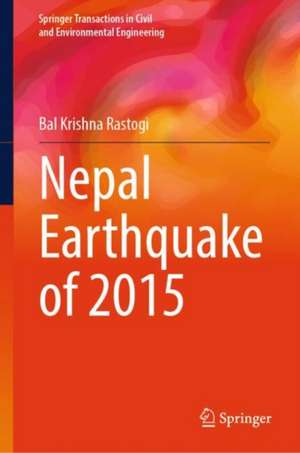Nepal Earthquake of 2015: Springer Transactions in Civil and Environmental Engineering
Autor Bal Krishna Rastogien Limba Engleză Hardback – 29 aug 2024
Din seria Springer Transactions in Civil and Environmental Engineering
- 15%
 Preț: 643.34 lei
Preț: 643.34 lei - 15%
 Preț: 647.40 lei
Preț: 647.40 lei - 18%
 Preț: 894.46 lei
Preț: 894.46 lei - 18%
 Preț: 902.36 lei
Preț: 902.36 lei - 18%
 Preț: 1008.12 lei
Preț: 1008.12 lei - 15%
 Preț: 606.04 lei
Preț: 606.04 lei - 18%
 Preț: 1126.52 lei
Preț: 1126.52 lei - 18%
 Preț: 956.03 lei
Preț: 956.03 lei - 15%
 Preț: 652.31 lei
Preț: 652.31 lei - 15%
 Preț: 654.95 lei
Preț: 654.95 lei - 15%
 Preț: 638.24 lei
Preț: 638.24 lei - 18%
 Preț: 1228.29 lei
Preț: 1228.29 lei - 24%
 Preț: 795.63 lei
Preț: 795.63 lei - 15%
 Preț: 652.64 lei
Preț: 652.64 lei - 24%
 Preț: 811.35 lei
Preț: 811.35 lei - 20%
 Preț: 1173.93 lei
Preț: 1173.93 lei - 18%
 Preț: 953.52 lei
Preț: 953.52 lei - 20%
 Preț: 547.79 lei
Preț: 547.79 lei - 24%
 Preț: 810.23 lei
Preț: 810.23 lei - 18%
 Preț: 954.93 lei
Preț: 954.93 lei - 24%
 Preț: 943.30 lei
Preț: 943.30 lei - 18%
 Preț: 939.94 lei
Preț: 939.94 lei - 18%
 Preț: 1399.43 lei
Preț: 1399.43 lei - 18%
 Preț: 1108.36 lei
Preț: 1108.36 lei - 24%
 Preț: 790.44 lei
Preț: 790.44 lei - 18%
 Preț: 1389.15 lei
Preț: 1389.15 lei - 15%
 Preț: 642.83 lei
Preț: 642.83 lei -
 Preț: 387.58 lei
Preț: 387.58 lei - 18%
 Preț: 960.13 lei
Preț: 960.13 lei - 24%
 Preț: 966.45 lei
Preț: 966.45 lei - 15%
 Preț: 644.63 lei
Preț: 644.63 lei - 18%
 Preț: 890.85 lei
Preț: 890.85 lei - 15%
 Preț: 647.40 lei
Preț: 647.40 lei - 20%
 Preț: 551.32 lei
Preț: 551.32 lei - 18%
 Preț: 1222.80 lei
Preț: 1222.80 lei - 24%
 Preț: 1049.22 lei
Preț: 1049.22 lei
Preț: 778.45 lei
Preț vechi: 949.33 lei
-18% Nou
Puncte Express: 1168
Preț estimativ în valută:
148.98€ • 154.96$ • 122.99£
148.98€ • 154.96$ • 122.99£
Carte disponibilă
Livrare economică 25 martie-08 aprilie
Preluare comenzi: 021 569.72.76
Specificații
ISBN-13: 9789819746835
ISBN-10: 9819746833
Pagini: 87
Ilustrații: XIV, 166 p. 100 illus. in color.
Dimensiuni: 155 x 235 x 12 mm
Greutate: 0.34 kg
Ediția:2024
Editura: Springer Nature Singapore
Colecția Springer
Seria Springer Transactions in Civil and Environmental Engineering
Locul publicării:Singapore, Singapore
ISBN-10: 9819746833
Pagini: 87
Ilustrații: XIV, 166 p. 100 illus. in color.
Dimensiuni: 155 x 235 x 12 mm
Greutate: 0.34 kg
Ediția:2024
Editura: Springer Nature Singapore
Colecția Springer
Seria Springer Transactions in Civil and Environmental Engineering
Locul publicării:Singapore, Singapore
Cuprins
Salient Aspects of the 2015 Mw 7.8 Gorkha Nepal Earthquake in Central Himalaya.- Geological Deformation in Himalaya.- Geodetic Deformation due to Mw7.8 Gorkha Nepal Earthquake of 2015.- Strong motion study of 2015 Nepal earthquake of magnitude 7.8.- Damage and Intensity of Gorkha Nepal Earthquake of 2015.- Behavior of Aftershocks of Gorkha Nepal Earthquake of 2015.- The Gorkha (Nepal) Earthquake of April 25, 2015: Rescue, Relief and Rehabilitation.
Notă biografică
Prof. Bal Krishna Rastogi is the former director general of the Institute of Seismological Research, Gandhinagar, and former head of Seismology at India’s National Geophysical Research Institute, Hyderabad. He is the founder and president of the Indian Society of Earthquake Science (ISES). He has been instrumental in developing several strong Seismology groups in India. His areas of research in seismology include probabilistic and deterministic seismic hazard assessment; seismic microzonation; earthquake hazard assessment for critical structures, like nuclear power plants, LNG terminals and dams; induced seismicity, source-mechanism of earthquakes, and earthquake prediction; plate tectonics, microearthquake surveys, and homogenization of earthquake catalogues and seismotectonics.
Textul de pe ultima copertă
This book describes the source parameters, faulting mechanism, slip distribution, rupture pattern, and aftershock behaviour of the Nepal Earthquake of 2015. This book sheds light on the damage pattern and the geodetic deformation and past seismicity and geology of the region. It also discusses empirical relations useful for assessing future earthquakes and the possible extent of damages caused by the different intensities, magnitude, and duration of aftershocks. Arguments discussed in the book are applicable not only to the Himalayan region but also for similar geological settings worldwide, helping improve disaster management and mitigation planning. This book is of interest to students, researchers, administrators, and planners engaged in earthquake risk reduction.
Caracteristici
Discusses how infrastructure damage in the Kathmandu basin was impacted by local geology and the ground motions Provides the damage pattern and aspects of rescue, rehabilitation, and reconstruction Presents useful empirical relations for rapid forecasting of different earthquake parameters
